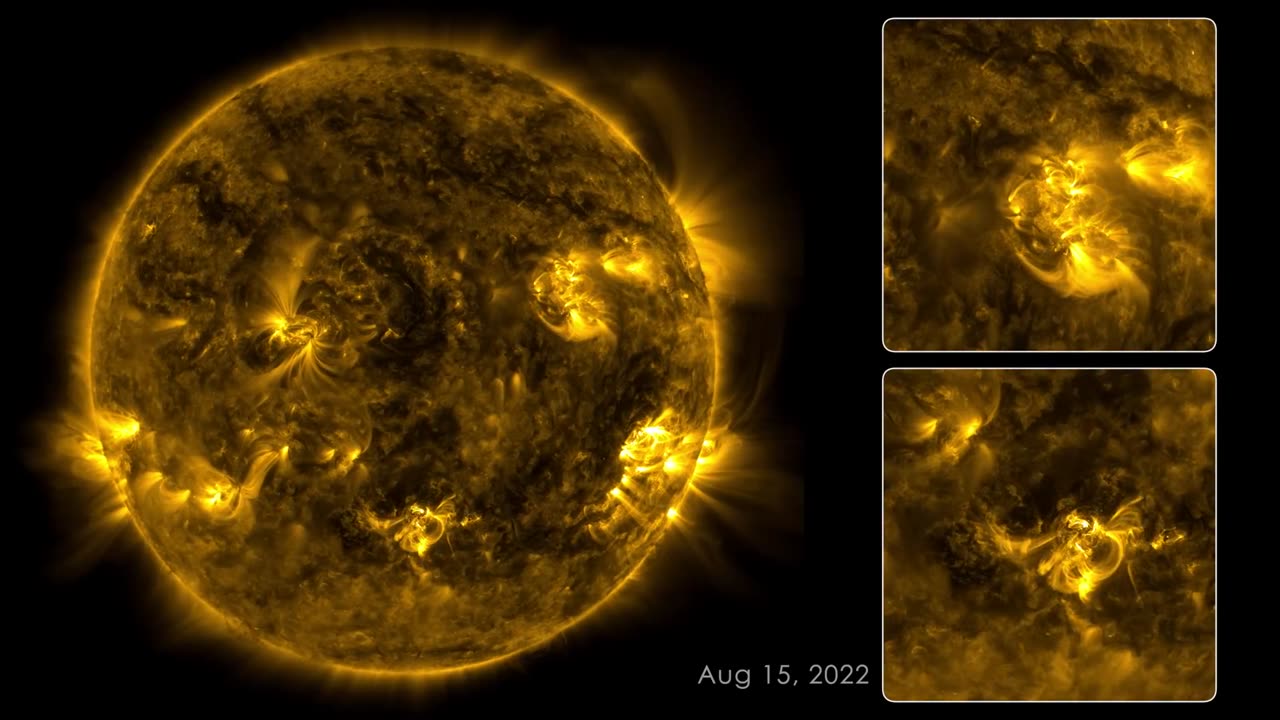Premium Only Content

133 Day's On The Sun
133 Days on the Sun
This video chronicles solar activity from Aug. 12 to Dec. 22, 2022, as captured by NASA’s Solar Dynamics Observatory (SDO). From its orbit in space around Earth, SDO has steadily imaged the Sun in 4K x 4K resolution for nearly 13 years. This information has enabled countless new discoveries about the workings of our closest star and how it influences the solar system.
With a triad of instruments, SDO captures an image of the Sun every 0.75 seconds. The Atmospheric Imaging Assembly (AIA) instrument alone captures images every 12 seconds at 10 different wavelengths of light. This 133-day time lapse showcases photos taken at a wavelength of 17.1 nanometers, which is an extreme-ultraviolet wavelength that shows the Sun’s outermost atmospheric layer: the corona. Compiling images taken 108 seconds apart, the movie condenses 133 days, or about four months, of solar observations into 59 minutes. The video shows bright active regions passing across the face of the Sun as it rotates. The Sun rotates approximately once every 27 days. The loops extending above the bright regions are magnetic fields that have trapped hot, glowing plasma. These bright regions are also the source of solar flares, which appear as bright flashes as magnetic fields snap together in a process called magnetic reconnection.
While SDO has kept an unblinking eye pointed toward the Sun, there have been a few moments it missed. Some of the dark frames in the video are caused by Earth or the Moon eclipsing SDO as they pass between the spacecraft and the Sun. Other blackouts are caused by instrumentation being down or data errors. SDO transmits 1.4 terabytes of data to the ground every day. The images where the Sun is off-center were observed when SDO was calibrating its instruments.
SDO and other NASA missions will continue to watch our Sun in the years to come, providing further insights about our place in space and information to keep our astronauts and assets safe.
The music is a continuous mix from Lars Leonhard’s “Geometric Shapes” album, courtesy of the artist.
Credit: NASA's Goddard Space Flight Center
Scott Wiessinger (PAO): Lead Producer
Tom Bridgman (SVS): Lead Visualizer
Scott Wiessinger (PAO): Editor
ctivity from Aug. 12 to Dec. 22, 2022, as captured by NASA’s Solar Dynamics Observatory (SDO). From its orbit in space around Earth, SDO has steadily imaged the Sun in 4K x 4K resolution for nearly 13 years. This information has enabled countless new discoveries about the workings of our closest star and how it influences the solar system.
With a triad of instruments, SDO captures an image of the Sun every 0.75 seconds. The Atmospheric Imaging Assembly (AIA) instrument alone captures images every 12 seconds at 10 different wavelengths of light. This 133-day time lapse showcases photos taken at a wavelength of 17.1 nanometers, which is an extreme-ultraviolet wavelength that shows the Sun’s outermost atmospheric layer: the corona. Compiling images taken 108 seconds apart, the movie condenses 133 days, or about four months, of solar observations into 59 minutes. The video shows bright active regions passing across the face of the Sun as it rotates. The Sun rotates approximately once every 27 days. The loops extending above the bright regions are magnetic fields that have trapped hot, glowing plasma. These bright regions are also the source of solar flares, which appear as bright flashes as magnetic fields snap together in a process called magnetic reconnection.
While SDO has kept an unblinking eye pointed toward the Sun, there have been a few moments it missed. Some of the dark frames in the video are caused by Earth or the Moon eclipsing SDO as they pass between the spacecraft and the Sun. Other blackouts are caused by instrumentation being down or data errors. SDO transmits 1.4 terabytes of data to the ground every day. The images where the Sun is off-center were observed when SDO was calibrating its instruments.
SDO and other NASA missions will continue to watch our Sun in the years to come, providing further insights about our place in space and information to keep our astronauts and assets safe.
The music is a continuous mix from Lars Leonhard’s “Geometric Shapes” album, courtesy of the artist.
Credit: NASA's Goddard Space Flight Center
Scott Wiessinger (PAO): Lead Producer
Tom Bridgman (SVS): Lead Visualizer
Scott Wiessinger (PAO): Editor
-
 LIVE
LIVE
The Jimmy Dore Show
37 minutes agoJoy Reid DUMPED by MSNBC! European Leaders Warn of the Dangers of Peace! w/ John Mearsheimer
5,988 watching -
 LIVE
LIVE
Akademiks
3 hours agoDrake and PartyNextDoor '$$$4U' Album Sells 250K first week. BIG AK IS BACK.
4,222 watching -
 LIVE
LIVE
MyronGainesX
2 hours agoDan Bongino Named As Deputy Director Of FBI And CPAC Recap
2,037 watching -
 LIVE
LIVE
vivafrei
2 hours agoBarnes Live from Seattle - Defending Benshoof in a Case that is CRAY CRAY!
2,460 watching -
 LIVE
LIVE
Robert Gouveia
2 hours agoLiberals EXPLODE over Elon's Email; Lawsuits FLY; Sanctions?? Congrats Dan!
2,310 watching -
 1:33:36
1:33:36
Redacted News
2 hours agoBREAKING! PUTIN LAUNCHES MASSIVE OFFENSIVE IN UKRAINE AS EUROPEAN LEADERS PUSH FOR MORE WAR
41.3K120 -
 44:39
44:39
Kimberly Guilfoyle
3 hours agoBetter Days Ahead for the FBI, Live with Asm Bill Essayli & John Koufos | Ep.199
19.7K14 -
 1:40:29
1:40:29
In The Litter Box w/ Jewels & Catturd
23 hours agoWhat Did You Do Last Week? | In the Litter Box w/ Jewels & Catturd – Ep. 748 – 2/24/2025
62.7K23 -
 23:34
23:34
Stephen Gardner
3 hours ago🔥CNN PANICS over $5000 DOGE Dividend | Trump Orders bigger Audits
24.2K79 -
 1:53:54
1:53:54
The White House
5 hours agoPresident Trump Holds a Press Conference with President Emmanuel Macron of France
49K36